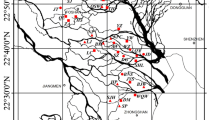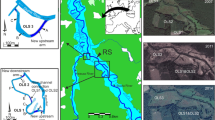Abstract
At present, there are few studies on the quantitative analysis of connectivity from the perspective of biocenology. This study aimed to develop a new quantitative assessment method for river connectivity based on the analysis of the effect of river connectivity on the phytoplankton community in the Shaying River, which has multiple gates. The results showed that from the view of the phytoplankton density and biomass, cryptophytes were the dominant phytoplankton group, but the cyanobacteria density was highest in the summer. In the top 10 of degrees of dominance, there were 4 species of cyanobacteria, 3 species of cryptophytes, 2 species of diatoms, and 1 species of chlorophytes. Based on the seasonal compositions and variations of the phytoplankton community, the river barriers had a great effect on the community. The community composition of the Shaying River has been transformed from a river-type community dominated by diatoms to a lake-type community dominated by cyanophytes. PCA (principal component analysis) indicated that there were obvious differences in the community structure among the sections partitioned by various river gates. According to the relative positions of the entire phytoplankton community and the relative sequence of the river gates, a potential gradient representing the river connectivity can be found; thus, the river connectivity can be quantitatively described from the perspective of the phytoplankton community, and hereby, the corresponding quantitative methods can be established. Characterizing the connectivity of rivers based on biota will facilitate assessing the effects of multiple barriers and understanding river connectivity, and provide the support for the effective management of rivers.






Similar content being viewed by others

References
Anderson, M. J., & Willis, T. J. (2003). Canonical analysis of principal coordinates: a useful method of constrained ordination for ecology. Ecology, 84(2), 511–525. https://doi.org/10.1890/0012-9658(2003)084[0511:CAOPCA]2.0.CO;2.
Bellinger, E. G., & Sigee, D. C. (2015). Freshwater algae: identification, enumeration and use as bioindicators (2nd ed.). New York: United States: John Wiley & Sons, Ltd.
Bracken, L. J., & Croke, J. (2007). The concept of hydrological connectivity and its contribution to understanding runoff-dominated geomorphic systems. Hydrological Processes, 21(13), 1749–1763. https://doi.org/10.1002/hyp.6313.
Bracken, L. J., Turnbull, L., Wainwright, J., & Bogaart, P. (2015). Sediment connectivity: a framework for understanding sediment transfer at multiple scales. Earth Surface Processes and Landforms, 40(2), 177–188. https://doi.org/10.1002/esp.3635.
Bracken, L. J., Wainwright, J., Ali, G. A., Tetzlaff, D., Smith, M. W., Reaney, S. M., & Roy, A. G. (2013). Concepts of hydrological connectivity: research approaches, pathways and future agendas. Earth-Science Reviews, 119, 17–34. https://doi.org/10.1016/j.earscirev.2013.02.001.
Cavalli, M., Trevisani, S., Comiti, F., & Marchi, L. (2013). Geomorphometric assessment of spatial sediment connectivity in small Alpine catchments. Geomorphology, 188, 31–41. https://doi.org/10.1016/j.geomorph.2012.05.007.
Chi, S., Wei, C., Zheng, J., Hu, J., Li, M., & Hu, J. (2018). Distribution patterns of macroinvertebrate communities in a Chinese floodgate-regulated river and their relationships with river longitudinal connectivity. Science of The Total Environment, 631–632, 765–777. https://doi.org/10.1016/j.scitotenv.2018.02.132.
Cote, D., Kehler, D. G., Bourne, C., & Wiersma, Y. F. (2009). A new measure of longitudinal connectivity for stream networks. Landscape Ecology, 24(1), 101–113. https://doi.org/10.1007/s10980-008-9283-y.
Crook, K. E., Pringle, C. M., & Freeman, M. C. (2009). A method to assess longitudinal riverine connectivity in tropical streams dominated by migratory biota. Aquatic Conservation: Marine and Freshwater Ecosystems, 19(6), 714–723. https://doi.org/10.1002/aqc.1025.
Davis, S., Golladay, S. W., Vellidis, G., & Pringle, C. M. (2003). Macroinvertebrate biomonitoring in intermittent coastal plain streams impacted by animal agriculture. Journal of Environmental Quality, 32(3), 1036–1043. https://doi.org/10.2134/jeq2003.1036.
Ferreira, J. G., Wolff, W. J., Simas, T. C., & Bricker, S. B. (2005). Does biodiversity of estuarine phytoplankton depend on hydrology? Ecological Modelling, 187(4), 513–523. https://doi.org/10.1016/j.ecolmodel.2005.03.013.
Ferris, J. A., & Lehman, J. T. (2007). Interannual variation in diatom bloom dynamics: roles of hydrology, nutrient limitation, sinking, and whole lake manipulation. Water Research, 41(12), 2551–2562. https://doi.org/10.1016/j.watres.2007.03.027.
Griffith, M. B., Hill, B. H., McCormick, F. H., Kaufmann, P. R., Herlihy, A. T., & Selle, A. R. (2005). Comparative application of indices of biotic integrity based on periphyton, macroinvertebrates, and fish to southern Rocky Mountain streams. Ecological Indicators, 5(2), 117–136. https://doi.org/10.1016/j.ecolind.2004.11.001.
Hong, S., & CHen, J. (2002). Structure characteristics of aquatic community from the main rivers in China. Acta Hydrobiologica Sinica, 26(3), 295–305.
Hu, H. (1980). Freshwater algae in China. Shanghai: Scientific and Technical Publisher.
Istvánovics, V., Honti, M., Vörös, L., & Kozma, Z. (2010). Phytoplankton dynamics in relation to connectivity, flow dynamics and resource availability—the case of a large, lowland river, the Hungarian Tisza. Hydrobiologia, 637(1), 121–141. https://doi.org/10.1007/s10750-009-9991-6.
JÖHnk, K. D., Huisman, J. E. F., Sharples, J., Sommeijer, B. E. N., Visser, P. M., & Stroom, J. M. (2008). Summer heatwaves promote blooms of harmful cyanobacteria. Global Change Biology, 14(3), 495–512. https://doi.org/10.1111/j.1365-2486.2007.01510.x.
Jones, I. D., & Elliott, J. A. (2007). Modelling the effects of changing retention time on abundance and composition of phytoplankton species in a small lake. Freshwater Biology, 52(6), 988–997. https://doi.org/10.1111/j.1365-2427.2007.01746.x.
Jun, S., Dongyan, L., & Shuben, Q. (1999). Study on phytoplankton biomass I. Phytoplankton measurement biomass from cell volume or plasma volume. Acta Oceanology Sinica, 21(2), 75–85.
Kane, D. D., Gordon, S. I., Munawar, M., Charlton, M. N., & Culver, D. A. (2009). The Planktonic index of biotic integrity (P-IBI): an approach for assessing lake ecosystem health. Ecological Indicators, 9(6), 1234–1247. https://doi.org/10.1016/j.ecolind.2009.03.014.
Kruk, C., Huszar, V. L. M., Peeters, E. T. H. M., Bonilla, S., Costa, L., LÜRling, M., et al. (2010). A morphological classification capturing functional variation in phytoplankton. Freshwater Biology, 55(3), 614–627. https://doi.org/10.1111/j.1365-2427.2009.02298.x.
Lacouture, R. V., Johnson, J. M., Buchanan, C., & Marshall, H. G. (2006). Phytoplankton index of biotic integrity for Chesapeake Bay and its tidal tributaries. Estuaries and Coasts, 29(4), 598–616.
Lasne, E., Lek, S., & Laffaille, P. (2007). Patterns in fish assemblages in the Loire floodplain: the role of hydrological connectivity and implications for conservation. Biological Conservation, 139(3–4), 258–268.
Lepistö, L., Holopainen, A.-L., & Vuoristo, H. (2004). Type-specific and indicator taxa of phytoplankton as a quality criterion for assessing the ecological status of Finnish boreal lakes. Limnologica - Ecology and Management of Inland Waters, 34(3), 236–248. https://doi.org/10.1016/S0075-9511(04)80048-3.
LI, Y., SHI, Z., ZHANG, Y., ZHAO, Q., LI, A., JIN, Y., et al. (2014). Evaluation methods and application on cyanobacteria bloom degree classification with algal density (in Chinese). Environment and sustainable development, (2), 67–68.
Liu, X., Lu, X., & Chen, Y. (2012). Temporal and spatial dynamics of cryptophytes biomass in the north of Lake Taihu (in Chinese). Journal of Lake Science, 24(1), 142–148.
LÜRling, M., Eshetu, F., Faassen, E. J., Kosten, S., & Huszar, V. L. M. (2013). Comparison of cyanobacterial and green algal growth rates at different temperatures. Freshwater Biology, 58(3), 552–559. https://doi.org/10.1111/j.1365-2427.2012.02866.x.
Ma, J., Deng, J., Boqiang, Q., & Long, S. (2013). Process and prospects on cyanobacteria bloom-forming mechanism in lakes. Acta Ecologica Sinica, 33(10), 3020–3030.
Moilanen, A., & Hanski, I. (2001). On the use of connectivity measures in spatial ecology. Oikos, 95(1), 147–151. https://doi.org/10.1034/j.1600-0706.2001.950116.x.
Moilanen, A., & Nieminen, M. (2002). Simple connectivity measures in spatial ecology. Ecology, 83(4), 1131–1145. https://doi.org/10.1890/0012-9658(2002)083[1131:SCMISE]2.0.CO;2.
Nalewajko, C., & Murphy, T. P. (2001). Effects of temperature, and availability of nitrogen and phosphorus on the abundance of Anabaena and Microcystis in Lake Biwa, Japan: an experimental approach. [journal article]. Limnology, 2(1), 45–48. https://doi.org/10.1007/s102010170015.
Obolewski, K., Stgrzelczak, A., & Glińska-Lewczuk, K. (2014). Does hydrological connectivity affect the composition of macroinvertebrates on Stratiotes abides L. in oxbow lakes? Ecological Engineering, 66(2), 72–81.
Pace, M. L., Findlay, S. E. G., & Lints, D. (1992). Zooplankton in advective environments: the Hudson River community and a comparative analysis. Canadian Journal of Fisheries and Aquatic Sciences, 49(5), 1060–1069. https://doi.org/10.1139/f92-117.
Rangel, L. M., Silva, L. H. S., Rosa, P., Roland, F., & Huszar, V. L. M. (2012). Phytoplankton biomass is mainly controlled by hydrology and phosphorus concentrations in tropical hydroelectric reservoirs. Hydrobiologia, 693(1), 13–28. https://doi.org/10.1007/s10750-012-1083-3.
Reynolds, C. S. (2006). The Ecology of phytoplankton. Cambridge, United Kingdom: Cambridge University Press.
Rodrigues, L. C., Simões, N. R., Bovo-Scomparin, V. M., Jati, S., Santana, N. F., Roberto, M. C., & Train, S. (2015). Phytoplankton alpha diversity as an indicator of environmental changes in a neotropical floodplain. Ecological Indicators, 48, 334–341. https://doi.org/10.1016/j.ecolind.2014.08.009.
Schick, R. S., & Lindley, S. T. (2007). Directed connectivity among fish populations in a riverine network. Journal of Applied Ecology, 44(6), 1116–1126. https://doi.org/10.1111/j.1365-2664.2007.01383.x.
Shi, Q., & Xin, Y. (1993). Several common kinds of cryptophytes in spring in Province Jinan (in Chinese). Journal of plankton Sincia, (3), 26–27.
Shu, W., Hu, J., Chen, S., & Chi, S. (2014). Zoobenthos community of the main stream of Shaying river at ecological restoration stage after watershed management (in Chinese). Journal of hydroecology, 35(4), 35–42.
Smilauer, P., & Leps, J. (2014). Multivariate analysis of ecological data using Canoco 5 (Second ed.). New York: Cambridge University Press.
Song, X., Liu, Z., Pan, H., Yang, G., & Chen, Y. (2007). Phytoplankton community structure in Meiliang Bay and Lake Wuli of Lake Taihu (in Chinese). Journal of Lake Science, 19(6), 643–651.
Tischendorf, L., & Fahrig, L. (2000). On the usage and measurement of landscape connectivity. Oikos, 90(1), 7–19. https://doi.org/10.1034/j.1600-0706.2000.900102.x.
Urban, D., & Keitt, T. (2001). Landscape connectivity: a graph-theoretic perspective. Ecology, 82(5), 1205–1218. https://doi.org/10.1890/0012-9658(2001)082[1205:LCAGTP]2.0.CO;2.
Wagner, C., & Adrian, R. (2009). Cyanobacteria dominance: quantifying the effects of climate change. Limnology and Oceanography, 54(6part2), 2460–2468. https://doi.org/10.4319/lo.2009.54.6_part_2.2460.
Wang, Z. (2014). Study on joint dispatching of water quality and quantity in Gate Dam group on Shaying River (in Chinese). Northwest hydroelectric, (1), 1–6.
Wild-Allen, K., & Andrewartha, J. (2016). Connectivity between estuaries influences nutrient transport, cycling and water quality. Marine Chemistry, 185, 12–26. https://doi.org/10.1016/j.marchem.2016.05.011.
Williams, M., Longstaff, B., Buchanan, C., Llansó, R., & Dennison, W. (2009). Development and evaluation of a spatially-explicit index of Chesapeake Bay health. Marine Pollution Bulletin, 59(1), 14–25. https://doi.org/10.1016/j.marpolbul.2008.11.018.
Wohl, E. (2017). Connectivity in rivers. Progress in Physical Geography, 41(3), 345–362. https://doi.org/10.1177/0309133317714972.
Wohl, E., Rathburn, S., Chignell, S., Garrett, K., Laurel, D., Livers, B., Patton, A., Records, R., Richards, M., Schook, D. M., Sutfin, N. A., & Wegener, P. (2017). Mapping longitudinal stream connectivity in the North St. Vrain Creek watershed of Colorado. Geomorphology, 277, 171–181. https://doi.org/10.1016/j.geomorph.2016.05.004.
Zhang, Z., & Huang, X. (1991). Research methods of freshwater plankton (In Chinese). Beijing: Science Press.
Author information
Authors and Affiliations
Corresponding author
Additional information
Publisher’s note
Springer Nature remains neutral with regard to jurisdictional claims in published maps and institutional affiliations.
Rights and permissions
About this article
Cite this article
Hu, J., Chi, S. & Hu, J. An attempt to measure longitudinal connectivity based on the community structure of phytoplankton. Environ Monit Assess 191, 382 (2019). https://doi.org/10.1007/s10661-019-7511-3
Received:
Accepted:
Published:
DOI: https://doi.org/10.1007/s10661-019-7511-3



